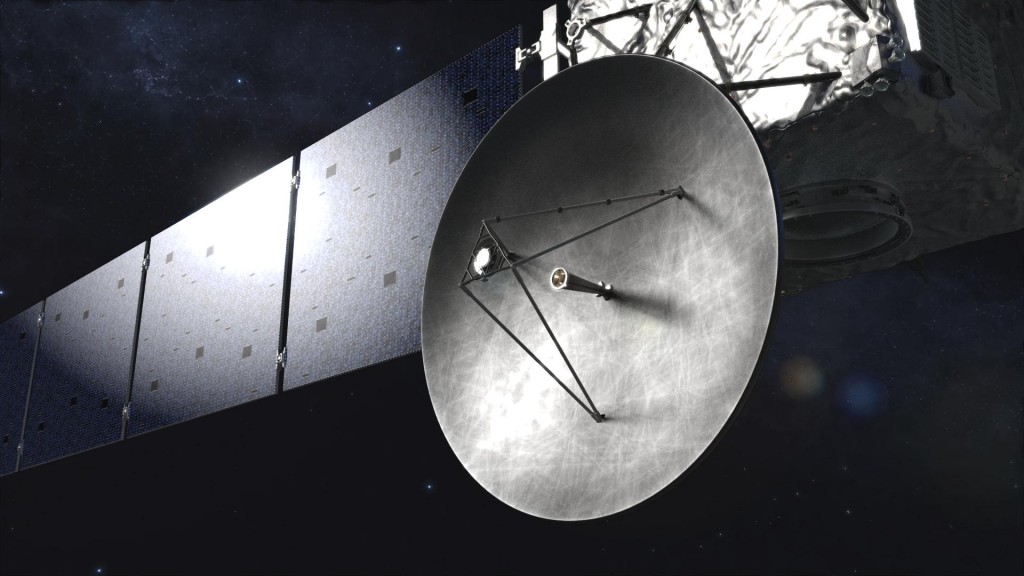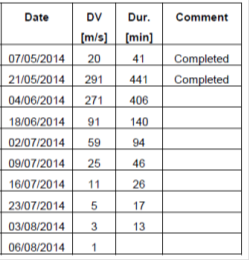It’s burn week in space again!
During May-August, Rosetta is executing a series of 10 orbit correction manoeuvres (OCM – aka thruster burns) to line itself up for arrival at comet 67P on 6 August – approximately one burn every two weeks in May and June, and one per week in July (see chart below).

Frame from ‘Chasing A Comet – The Rosetta Mission’ https://www.youtube.com/watch?v=5b7u6stKgfs Credit: DLR (CC-BY 3.0)
The first, on 7 May, was quite small, achieving a ‘delta-v’ (change in velocity with respect to the comet) of just 20 m/second. But the next OCMs – Nos. 2, 3 and 4, referred to as ‘NCD burns’ for Near Comet Drift – are whoppers!
The second was carried out on 21 May, which we dubbed the #BigBurn: it ran 7hrs and 16mins, used 218kg of propellant and delivered a total delta-v of 289.59 m/second – a tiny performance difference of 0.52% with respect to that planned.
It was one of the longest thruster burns conducted by any of ESA’s spacecraft.
The next OCM – #BigBurn2 – is set for tomorrow, and based on results of the last burn, it is set to run for about 6hr:41mins and achieve a delta-v of 269.5 m/sec.
“The planned delta-v for tomorrow’s burn is a bit less than what we forecast back in April, but it takes into account the results delivered on 21 May,” says Rosetta Spacecraft Operations Manager Sylvain Lodiot.
“For the rest of the series, we’ll adjust each burn based on the actual performance of the previous and on the continuous improvement of our knowledge of the comet’s orbit.”
The comet’s trajectory is being regularly refined by analysing images taken with the OSIRIS camera and the navigation camera.

Gerhard Schwehm, Cometary scientist, ESA, gives an overview of the Rosetta mission at the ‘Space for Earth’ space pavilion at ILA, the Berlin Air and Space Show, on 24 May 2014. Credit: ESA–M. Pedoussaut
Wednesday’s burn will be triggered automatically by pre-uploaded commands, and will get underway at 16:21 CEST (14:21 UTC), spacecraft event time.
The burn will take place during a ground station communication slot, and the team at ESOC will monitor telemetry – spacecraft health and status signals – in real-time via ESA’s 35m tracking station at New Norcia, Australia.
During the 21 May OCM, teams at ESOC monitored parameters such as temperature and pressure for the four thrusters (the axial thrusters – i.e. the ones that are pointed along the spacecraft’s Z-axis) that are being used to deliver the OCM thrust. All values were as expected.
The rest of the spacecraft’s systems – including power, thermal, attitude and orbit control, data handling and communications – operated as expected.
All in all, Rosetta’s working well, despite the fact that the orbiter’s thrusters are being used at lower pressure than originally planned because of a Reaction Control System leak that occurred in August 2006
“We are operating the spacecraft propulsion system at a pressure substantially below the design value, as a result of significant tuning of the AOCS [attitude and orbit control system] to avoid the issues previously observed,” says Sylvain.
“The system is providing the thrust we need to get us where we need to be.”
(See note below – Ed.)
Rosetta was launched with 1719 kg of propellant, and currently has enough remaining to arrive at the comet and conduct planned science.
On 4 June, before the burn, Rosetta will be 425,250 km from the comet, and will be moving at a speed (Vrel) of 463 m/s with respect to the comet. The one-way radio signal time to Earth will be 25 min:56 sec.
On 23 May, the spacecraft passed the 4 AU (Astronomical Unit) boundary, at 597 million km from the Sun.
ROSETTA OCM PLAN MAY-AUG 2014
as of 3 June
Note: The primary risk to the mission involves the orbiter’s thrusters, which will have to perform at lower pressure than planned because of a Reaction Control System leak that occurred in September 2006.










Discussion: 9 comments
Very spectaculair to follow Rosetta aprox to the comet.
Thanks for all the information
Good Look Rosetta 🙂
Thanks for sharing your experience with us humans. Live long and prosper.
Just amazing.
With the displayed news, it’s just like if we were in the Mission Control room.
Excellent.
Thanks for sharing.
Serge/
THIS WILL BE SOME OF THE MOST EXCELLENT PIC’S ,WATCHING FROM THE COMETS SURFACE AS ROSE LANDS AND NEAR’S THE SUN.CAN’T WAIT. AND A FEW OTHER MILLION PEOPLE !
We live in exciting times
Comets don’t come that close to the sun – compared to mercury ; Tschuri stays well out of the orbit of the earth. But that’s enough to spit all that stuff.
The tiny gravity of Tschuri will require Rosetta to circle quite slowly around the comet.
All that, happening…out there, it all seems sooooooo remote and yet us puny humans are in control. The confidence to do these things amazes me. That we can actually do these things astounds me. Rosetta, just like the other probes in the outer reaches an extension of ourselves. Juno…all that way, Voyager, nearly dropping off the disc of the flat solar system, the Pioneers…New Horizons, Dawn…humans next? The will to leave is strong…can we do it, dare to dream!
human being can do anything…good luck Rosetta 🙂